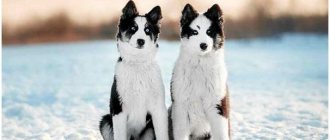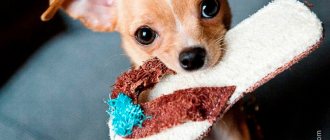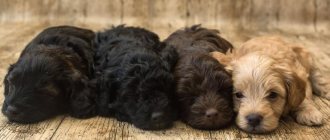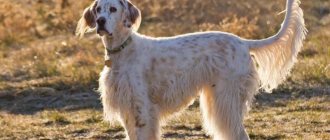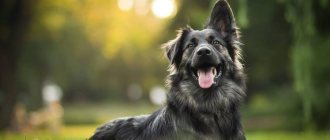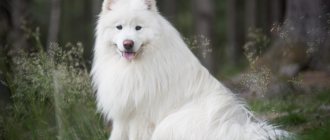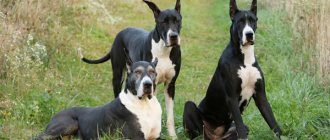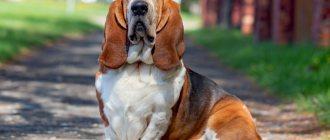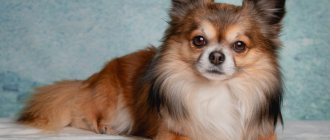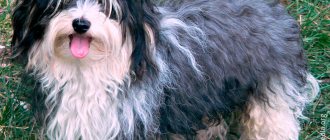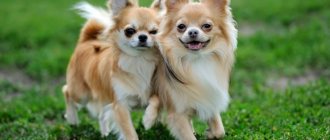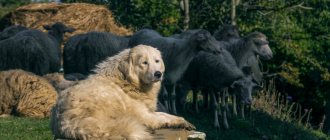Almost half of the four-legged population of the planet are fluffy dog breeds. For some, the fur coat serves as clothing and decoration, but most tailed animals need long, dense fur for work. It is important that dogs’ exteriors are judged by their fluffiness.
It is useless to argue that every person has his own opinion, but in this state of affairs, how can one determine who is fluffy, who is long-haired, and who is shaggy? If you look even deeper, the volume of hair of each dog depends not only on natural characteristics, but also on care. In our rating there is a place for most furry four-legged animals, and it’s up to you to decide who will receive the title of the most fluffy dog breed.
History of the origin of bobtails
Bobtails were bred in the central part of Great Britain, and therefore received a second name - the Old English Sheepdog. Among the English this name is more common than bobtail. It is believed that their ancestors were Briards and South Russian Shepherds, who were related to the Hungarian herding dogs. Initially, dogs were bred for only one purpose - herding livestock.
During the formation of the breed in Great Britain, farmland was located everywhere. Therefore, there has always been a demand for herding dogs. A dog that managed the herd well, was endowed with intelligence, and was able to make decisions on its own was always considered worth its weight in gold. Among herding breeds, bobtails are relatively young. The first mentions of them come from the 18th century.
There are many versions of the origin of this breed. Some researchers claim that shepherd dogs were brought to England in 2500 BC, but for a long period they did not find popularity and were kept in the shadow of other breeds. Sometimes they are considered to be the descendants of Roman dogs that Caesar's legionnaires brought to England. Some people find an external resemblance to a puli and classify shepherd dogs as descendants of Russian dogs.
Farmers claimed that one animal was quite capable of coping with a herd of sheep numbering 200-300 heads. Dogs often worked independently in pastures, without the presence of shepherds. In England, there were even competitions between shepherd breeds, where competitors had to gather sheep and herd them into a small pen, separating their owner’s sheep from the rest.
Talented individuals could even choose one single “own” sheep among a huge flock of others. The most difficult task was to drive 10 sheep from my own herd through someone else's. The dogs ran around their charges in a circle and little by little drove them to the designated place. If any individual strayed from the herd, the shepherd dogs caught up with it and returned it to the flock. The bobtails were always the winners.
The breed was first presented at an exhibition in 1865 in the English town of Islington. In the first year, only two individuals were entered and both were named Bob. The breed standard was officially recognized only in 1888. The first dogs appeared in Russia only in 1970. They quickly found fans thanks to their interesting appearance and easy-going nature. The largest nurseries are located in Moscow.
Tibetan mastiff
A huge shaggy dog that you will never forget once you see. The breed amazes not only with its incredible thick coat, but also with its size. The height of a show dog ranges from 66 centimeters, but mastiffs in their homeland, which are still raised as watchdogs, are much larger.
The breed is not very common, and like all giant dogs, it is difficult to train and maintain. Accustoming a dog to grooming is a lot of work, teaching it to get along with people is even more difficult. It is recommended to own a Mastiff only for very experienced dog breeders or people who are constantly in contact with the breed at their place of residence.
Australian Shepherd
Otherwise known as Aussies, this fluffy breed is extremely beautiful. Australian Shepherds have crisp, clear and expressive eyes. They belong to the class of medium breeds. Aussies have somewhat elongated bodies, relatively large heads, which, thanks to their long hair, look neat and light.
The length of the muzzles of Australian Shepherds is average, the nose lobes are pigmented, and the pigment depends on the color of the coat. Thus, black pigmentation can most often be found in blue and dark Australian Shepherds, and brown pigmentation can be found in red ones, including marbled ones.
White Swiss Shepherd
Literally the personification of beauty - the white Swiss shepherd. In general, the breed resembles a German Shepherd, but there is one difference: the color and relative density, fleshiness of the White Swiss. The breed can be either long-haired or have medium-length hair, but at the same time thick: hair on the body and limbs grows frequently.
The muzzle of the White Swiss Shepherd is proportional to the body, clear and wedge-shaped. Erect, slightly forward ears in the shape of an inverted Latin V are unlikely to leave indifferent a lover of man's faithful friends - dogs. The breed is also characterized by the presence of slanted, almond-shaped eyes with a brown color.
Dalmatian dog
Bright, elegant Dalmatians are remembered at first sight due to their peculiar spotted color. Black or brown spots scattered on a white background form a unique pattern in each animal.
Dalmatian puppies are born white, with a spotted pattern appearing at 2–3 months.
Dalmatian dogs are extremely active and cheerful. They love to be in the center of events, communicate with family, and take long walks.
The average height of a Dalmatian is 60 cm.
Dalmatians are often born deaf in one or both ears. This defect is associated with the color gene, but is not fully understood. According to statistics, every fifth representative of the breed suffers from unilateral hearing loss. But breeders and owners may not even suspect this and allow the dog to be bred: the animal hears perfectly well with the other ear.
The site has published a story-review from a site reader about her Dalmatian Cassandra (will open in a new tab).
French lap dog - Bichon Frize
The lap dogs were not bred artificially. Small white dogs with fluffy curly or wavy hair lived on the coast and islands of the Mediterranean Sea and became the ancestors of all lapdogs.
The FCI groups them into the Bichon group. This name comes from the French word bichonner - to curl, care for, dress up.
French sailors were the first to find Bichons. At first, dogs traveled on ships where they worked as rat catchers. During the Renaissance, they spread to France, England, Italy, Spain, and became favorites of the aristocracy and circus performers. In each country, lap dogs were improved in their own way.
French lapdog puppy.
The Bichon Frize breed was developed in France and Belgium. These are small but dense dogs with ears hanging down along the cheeks. The wool curls into springy curls in a spiral and grows up to 10 cm.
The only color of the Bichon Frize is white.
Bichons are calm, good-natured dogs. They do not show aggression towards people and animals, even strangers. French lap dogs have a stable psyche. Dogs easily adapt to the owner's temperament and do not bark without a reason. The lifespan of a Bichon Frize is 12 to 15 years.
See on topic: Dog name generator
Rottweiler
According to the standard, this breed is not completely black; there are red areas on the chest and face of the animal. The Rottweiler's build is stocky and muscular. The breed was originally bred to transport small loads, but now this dog serves as a guard. He is very jealous of his territory and is wary of strangers.
Read The best dogs for children - top 20 breeds
The coat is very thick and short, requiring no special care. Due to their thick undercoat, they tolerate cold well. Dogs of this breed must be trained, and this should be done by professionals. An untrained Rottweiler can pose a threat even to its owners.
Neapolitan Mastiff
Comes from the oldest families of dogs and was a companion of Alexander the Great, as well as Cyrus and the Phoenician sailors. For a long time he enlivened the arenas of the Colosseum in Rome. Despite the fall of the Roman Empire, he remained guardian of the villas in southern Italy. Saved from extinction at least, it was only in 1946 that he began to be seen at exhibitions.
The Neapolitan Mastiff, a breed of Italian origin, is a powerful mastiff of impressive build with a massive, broad head and short muzzle - this is the image of a mastiff.
This wrinkled face with a well-defined square shape remains very characteristic of the Neapolitan Mastiff breed. Its well-built body is covered with short hair, the color of which ranges from fawn to black through various shades of gray.
Sturdy, rustic, imposing, this is an excellent guard dog, but also a good family companion, although it enjoys dominating its companions.
He needs exercise and is not content with a living space that is too small. Early education can only help the good integration of this companion, whose guarding instinct is innate and sufficient. The Neapolitan Mastiff needs to be exercised and cannot be kept indoors for too long.
Welsh Corgi
Squat, miniature and at the same time unusually strong, Welsh Corgis have straight and thick hair (which is never wavy or soft) with a good undercoat. The coat color of the breed is often red; there may be individual spots of dark or white color. According to the breed standard, ash-red tan marks on the head or muzzle are acceptable.
The Welsh Corgi's paws are often short, but straight. Oval in shape, with strong toes and dense pads, they help the dog move quickly enough regardless of the terrain over which it moves.
Longhaired Chihuahua
Perhaps the smallest breed of fluffy dogs. It's a matter of size - adult individuals easily fit into the hands of their owners during walks. The breed should not be confused with the smooth-haired Chihuahua: it is less fluffy.
The incredibly soft and long coat throughout the body of the longhaired breed can be either brilliant white or chestnut. This Chihuahua will definitely appeal to those who like dogs to have long fur. And so that they fit under the arm!
Small furry breeds
Photos of very fluffy dogs usually show the smallest breeds. I would rather call larger animals shaggy.
Miniature dogs weigh no more than 10 kg. They do not require much space and can even live in a studio apartment. Also, such pets quickly get used to the tray and eat very small portions of food.
Their only drawback is increased fragility. For this reason, they should not be purchased for hyperactive children who do not know how to properly handle pets.
Pomeranian Spitz
Fluffy “bells” with a ringing voice are wonderful companions for conscientious children. Under the soft fur of the Pomeranian there is a dense undercoat. The presence of wavy hairs and curls is not typical for this breed.
Health problems in Spitz often affect the condition of the coat. If bald spots appear on your pet's body, be sure to contact your veterinarian. In the best case, it will be enough to change your diet or choose new cosmetics.
Maltese (Maltese)
This unusually emotional dog with shaggy snow-white fur is notable for its hypoallergenicity. Unlike the Malamute, a lower likelihood of an allergic reaction is achieved due to scanty and infrequent shedding.
Small fluffies have light, straight guard hair and a weak undercoat. The Maltese fur coat feels like silk to the touch. The presence of fringes and protruding hairs is permissible only on the back of the paws. In all other places, this feature of appearance is equated to marriage.
French lapdog (Bichon Frize)
The Bichon Frize is another snow-white variety of lapdog. Like Maltese, it is hypoallergenic and does not have a specific dog smell. Thanks to its fluffiness and small dimensions, the Bichon Frize resembles a weightless cloud.
Despite its airiness and curliness, the coat of the French lapdog is not prone to tangling. The main problem with caring for this dog is that it often gets stuck in debris. Small grains of sand and blades of grass that get tangled in the hairs must be removed after each walk.
Papillon
Graceful Papillons are famous for their “butterfly ears.” In addition to the ears, long and wavy fur covers the back of the front legs, neck and thighs. The undercoat of these dogs is poorly developed, so with the onset of cold weather they must be dressed in insulated overalls.
Please note that you can only comb your Papillon after it is wet. Otherwise, his hairs will become brittle.
Pekingese
Flat-faced fluffies are very proud and indulgent in affection only when they are in a good mood. Their coat consists of thick guard hair and a very delicate undercoat. On the neck, long hairs form a lush collar.
Unlike other shaggy four-legged animals, keeping the Pekingese is problematic not because of complex coat care, but because of the structural features of the muzzle. The short nasal passages of this dog impose a lot of restrictions regarding walking. They have the hardest time in hot and cold weather.
Shih Tzu
The owner of satin fur resembles a chrysanthemum flower. The longest hairs cover the muzzle and head. The first ones constantly get dirty while eating, and the second ones are effectively put away in a ponytail.
The Shih Tzu's coat is not only extremely susceptible to contamination, but is also prone to tangling. Because of this, the dog needs to be brushed daily.
For show pets, after washing, the fur is lubricated with special oils and wound on curlers. With the help of these devices, the Shih Tzu manages to maintain its presentable appearance until the exhibition.
Shetland Sheepdog (Sheltie)
In appearance, a Sheltie is practically no different from a Collie. Their only difference is size. The Shetland Sheepdog is about 2 times smaller, so you can safely take it into a small apartment.
Sheltie sheds a lot. During seasonal hair renewal, comb it twice a day. The advantages of the Shetland Sheepdog include the absence of a characteristic dog smell. It only appears when exposed to rain.
Dandie Dinmont Terrier
The breed was named after Dandy Damon, the literary hero of the novel by V. Hugo, who kept a whole pack of terriers. Dogs were bred in Scotland to guard farms and hunt badgers and foxes.
Behind the pretty appearance of the dandy dinmont lies an independent character.
Dandies are only partially fluffy. The elongated body is covered with a semi-rigid coat of mustard or pepper color up to 5 cm long. The head is decorated with a soft fluffy hat. The height of dogs is 20 – 28 cm.
Most often, dogs behave with restraint, but if they feel threatened, they can get into a fight. Dandies choose one owner and treat the rest with loyalty. They love to play with children, but will not tolerate mistreatment. They do not quarrel with domestic cats and dogs.
The average life expectancy of a Dinmont dandy is 12 years. For other small terriers up to 30 cm tall, read the article “Breeds of small terriers.”
Basic content rules
Long-haired small dogs are very gentle creatures
They need to be surrounded with warmth and care, attention and love. And then they will be very comfortable living with you side by side.
The first thing that requires attention when caring for such a pet is its nutrition. Long-haired babies are not suitable for human food. The exceptions are some fruits, low-fat cottage cheese and dried bread.
Their menu should consist of specialized food. As a rule, dry food is most suitable for them. But each breed has its own type of food. Be sure to add vitamin and mineral complexes to your pet’s basic diet. They will compensate for the deficiency of nutritional components, which will immediately affect the animal’s coat. It will become smooth and silky.
Your pet must have its own corner in the house. But remember that even despite their long hair, they do not tolerate low temperatures and hypothermia. Set up a comfortable place for your dog, small, cozy, protected from drafts, where he can retire, relax and unwind.
Get used to controlling your movements. You may not even notice how the nimble creature appears under your feet
It is important not to injure the baby
A very important point is raising your dog. You can make her a smart and savvy new member of the family if you work hard with her. Here everything is like with a small child: you need to explain to the baby what is good and what is bad. The dog should perceive you as an owner and leader, and not a soft-bodied individual from whom ropes can be twisted.
Do not deny your baby games and affection
Dogs love attention and need it constantly. By the way, toys play a significant role for such kids.
They simply love different squeakers, rattlers, balls and are always waiting for some new product.
In general, raising small dogs requires a harmonious blend of strictness and gentleness. Then you will get a wonderful friend, cheerful, active, amusing, giving you a whole range of positive emotions.
Small fluffy dogs are ideal for being pets. Preferring to be among people, distinguished by liveliness and cheerfulness, they bring a lot of joyful bustle and positive energy into the lives of their owners. But their miniature size does not mean that they require a minimum of care. Companion dogs cannot live without human attention and require a special, delicate approach.
In the next video you can watch a tiny Pomeranian puppy.
Papillon
Dog lovers, especially connoisseurs of fluffy dog breeds, often call Papillons butterflies. Exactly butterflies! The reason for this is simple and lies in the fact that the breed has incredibly fluffy ears, raised and such, the hair from which falls down in the form of wings.
Read Sled dogs - 20 popular breeds around the world
As for the hair in general: it is long, fluffy, and soft to the touch. The color is often bicolor: white fur predominates, on which red or brown spots may occasionally be found.
Medium furry breeds
This group includes fluffies with an average weight of 11-25 kg. Most of them are good with children and are famous for their friendliness. Less active representatives can be kept in an apartment.
Australian Shepherd (Aussie)
The density of the Aussie's fluffy coat depends on the region of residence: the warmer it is, the lower the density of the undercoat. According to the standard, the coat can be straight or slightly wavy.
The smoothest and shortest coat covers the head, ears, lower part of the front legs and hocks, and the longest coat covers the hind legs. Males of this breed are also notable for their pronounced collar and mane.
The intensity of Australian Shepherd shedding depends on the humidity level. The drier the air, the more dog fluff scatters. For this reason, it is recommended to buy a humidifier for your home.
Chow chow
Thanks to its fluffiness, the Chow Chow resembles a teddy bear. The long hairs on their neck form a luxurious mane, and on their paws there are peculiar “pants”.
A clean and balanced Chow Chow is suitable for living in an apartment. Its fur practically does not get dirty due to its dirt-repellent properties. For this reason, bath procedures should be carried out no more than 2-3 times a year.
Samoyed dog (Samoyed)
These snow-white fluffies are a real find for allergy sufferers. Despite the abundance of wool, they rarely cause allergies. The thing is that their body produces a reduced amount of protein foreign to humans.
Samoyeds are also notable for their ease of care. The luxurious fur coat self-cleans thanks to natural oils, so the owner can only brush it regularly. You will only have to wash your paws every day, since here only dog boots can save you from getting dirty.
Border Collie
Border collies are famous not only for their developed intelligence and obedience, but also for their shaggy appearance. According to the standard, they are smooth-haired and moderately long-haired. In both cases, the dog's body is covered with a soft and very warm undercoat. Long-haired individuals are distinguished by a lush “collar” on the neck and fluffy “pants”.
The Border Collie's coat is prone to tangling. It is recommended to comb it after moisturizing with conditioner every 2 days.
Siberian Husky
The mini version of the Alaskan Malamute has a shorter coat. The Husky's muscles are easier to see, and his hair is much softer to the touch. The hard coat of this breed is equated with disadvantages.
Husky is a very clean pet. It doesn't smell like a dog, doesn't drool all over the furniture, and doesn't get dirty for a very long time. The dog sheds naturally and does not need trimming.
Poodle
Regardless of size, poodles have a very thick and lush coat. In some varieties it bunches up into thin and delicate cords, and in others into elastic curls. The fluffiness of the latter strongly resembles lamb's wool.
When the poodle's hairs die, they accumulate directly in the fur coat. Because of this, the neat appearance of the animal depends entirely on the efforts of the owner. In addition to regular brushing and bathing, the poodle needs systematic haircuts. Due to the complexity of some options for show pets, it is better to immediately entrust the groomer.
